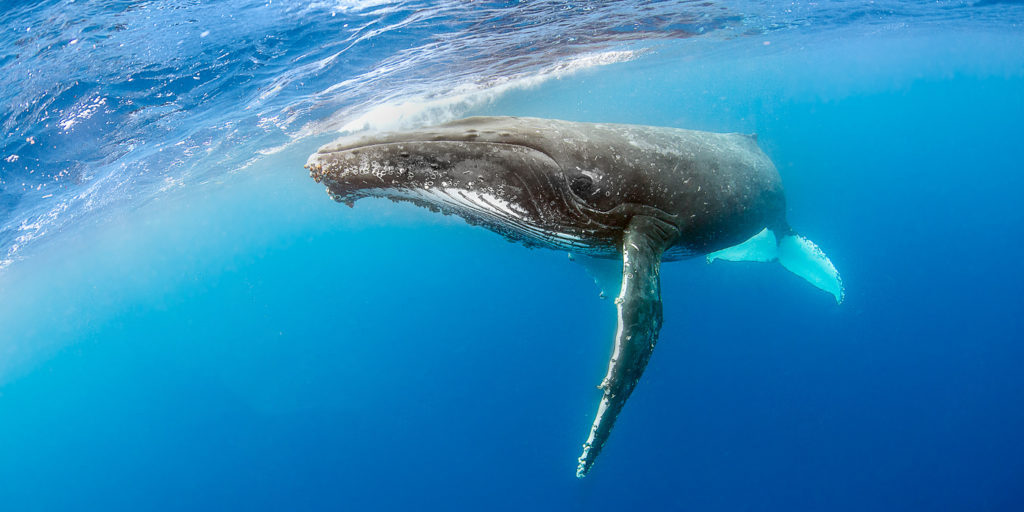What Do Humpback Whales Sound Like?

Every winter, humpback whales return to Hawaii’s warm waters after a long migration from Alaska. We see their spouts from a distance, watch calves playing at the surface, and sometimes even witness the spectacular power of a breach. But beneath the waves, something equally remarkable is happening: humpback whales are singing.
One of the most common questions we hear from guests on our tours: What do humpback whales sound like?
The answer is both scientific and profoundly moving. Let me share what we’ve learned over the years of guiding guests through whale season here in Kauai and our years of whale watching experience.
What Does a Whale Song Sound Like?
Humpback whale songs are long, patterned, and surprisingly musical.
- Length: Each song lasts 10–20 minutes and can be repeated for hours.
- Tone: Deep rumbles mixed with haunting cries and higher-pitched, flute-like notes.
- Volume: They can reach 180 decibels underwater, carrying for miles.
- Pattern: Songs are structured into “phrases” that repeat, more like verses of a song than random noise.
To the human ear, whale songs sound otherworldly — a blend of bass vibrations and eerie melodies. The first time we drop our hydrophone into the water and play it through the speakers on board, guests often just stand in silence.
Why Do Whales Sing?
Whale songs are sung only by males and mainly during the breeding season. Scientists are still studying the exact reasons, but the most accepted theories are:
- Courtship: Attracting females during mating season.
- Competition: Displaying strength and stamina to other males.
- Communication: Broadcasting presence across great distances.
- Cultural tradition: Songs change each year, shared and adapted by all the males in a region.
In other words, singing is both biological and cultural — a way for whales to connect, compete, and carry on traditions that shift over generations.
How Scientists Study Whale Songs
For decades, researchers have been recording and analyzing humpback whale songs to understand their complexity.
- Hydrophones: Underwater microphones capture sounds across broad ranges.
- Spectrograms: Scientists visualize whale songs as sound patterns, similar to sheet music.
- Long-term studies: By comparing recordings year after year, researchers have shown how songs evolve.
Interestingly, songs spread across populations. A new phrase introduced by one group may “travel” to others across the Pacific within a few seasons — a kind of cultural ripple effect.
Other Whale Sounds Beyond Songs
Songs aren’t the only sounds humpbacks make. Guests often see whale behaviors that create their unique noises:
- Tail Slapping (Lobtailing): A whale slams its tail against the surface, creating a powerful crack that carries underwater.
- Pectoral Fin Slapping: Massive fins slap against the water, often in rhythmic succession.
- Breaching: When a whale crashes back into the ocean, the sound wave is enormous.
- Calf Chatter: Young whales squeak, grunt, and click — playful sounds that show learning and curiosity.
These sounds may be social signals, warnings, or just playful expressions. Together, they create a complex soundscape beneath the surface.
The Cultural Significance of Whale Songs in Hawaii
In Hawaiian culture, humpback whales — or koholā — hold deep meaning. They are seen as guardians of the ocean and symbols of unity, strength, and navigation. Their arrival each winter has long been viewed as a sign of abundance.
When we share whale songs with guests, it isn’t just a scientific curiosity — it’s a chance to connect people to a cultural legacy and the living spirit of Hawaii’s waters.
When and Where Can You Hear Whale Songs in Kauai?
The best time is whale season, from December through April, with peak activity in January through March.
- Nā Pali Coast: Deep waters close to shore make it a prime location.
- ʻAuʻau Channel: Between Maui and Lānaʻi, another excellent area.
- On Tour: Hydrophones aboard our vessels provide the clearest experience.
Snorkelers and divers sometimes hear faint songs underwater, but for most visitors, a hydrophone is the most reliable way.
FAQ: Humpback Whale Songs
- Can Humans Hear Whale Songs Without Equipment?
- Snorkeling and Diving
Yes, you may hear faint, distant songs underwater. They often feel like vibrations in your body as much as sounds in your ears. - From a Boat
Not usually. Hydrophones are needed to make the songs audible above the surface.
- Snorkeling and Diving
- Do Female Humpbacks Sing?
No. Only males produce the long, complex songs. Females and calves make short sounds, but not structured songs. - How Long Do Whale Songs Last?
- Single Session
Each song runs 10–20 minutes. - Repetition
Males may sing for hours, repeating the same sequence dozens of times.
- Single Session
- How Loud Are Whale Songs?
At up to 180 decibels, they’re among the loudest animal sounds on Earth. For comparison, a jet engine is around 150 decibels. Underwater, the sound disperses as vibration instead of damaging noise. - How Far Can a Whale Song Travel?
Under ideal conditions, songs may travel 20–30 miles through water. - Do Whale Songs Change Every Year?
Yes. All males in a region sing the same song in a given season, but that song evolves. By the following year, parts may be added or dropped. - Do Calves Make Sounds?
Yes. Calves produce squeaks, clicks, and grunts. These are early communication tools, though they don’t sing structured songs until maturity. - Do Whales Sing at Night?
Yes. Singing continues day and night during the breeding season. Hydrophone studies confirm that songs carry through the night. - Can Visitors Record Whale Songs?
Yes. With hydrophones or specialized underwater microphones, visitors and researchers can capture songs. Many tours, including ours, play them live through onboard speakers. - Are Whale Songs the Same Everywhere?
No. Each population has its version. Hawaiian humpbacks sing differently from those in the South Pacific. - Do Other Whale Species Sing?
Some whale species vocalize, but humpback songs are unique for their length, complexity, and cultural evolution. Blue whales produce simple pulses, while sperm whales click for echolocation. - Are Whale Songs Harmful to Humans?
No. While loud, they don’t harm humans. Instead, people often describe the experience as calming, even meditative. - Do Whales Sing When Humans Are Nearby?
Generally, yes. Songs aren’t directed at humans, so our presence doesn’t stop them. Respectful, quiet conditions on the water help us hear them.
Fun Facts About Whale Songs and “Speech”
After years of listening to humpbacks in Kauai’s waters, we’ve learned plenty of fascinating scientific tidbits. Here are a few of our favorite facts to share with guests:
- All Males, One Song: Every male in the same region sings essentially the same song each season. It’s like a giant choir spread across miles of ocean.
- Yearly Remix: By the following season, that song changes — sometimes subtly, sometimes dramatically. Think of it as the whales’ version of a hit song that gets remixed every year.
- Dialects Across Oceans: Hawaiian humpbacks sing differently from whales in the South Pacific. If a whale travels between populations, it can actually “learn” a new version of the song.
- Not Random Noise: Whale songs are structured like human music, with verses, themes, and repeating phrases. Scientists even compare them to symphonies.
- Songs Are Long: A single song can last 20 minutes, and a male may sing it for hours on end without stopping.
- They Sing at Night: Hydrophone recordings show that whales sing both day and night during the breeding season.
- Whale “Speech”: Beyond songs, whales also make shorter sounds — squeaks, grunts, and knocks — almost like a vocabulary of social communication. These quick sounds are thought to be the whales’ everyday “speech,” while songs are more like performances during courtship.
- Songs Travel Miles: Underwater, a song can carry 20 miles or more, reaching whales far beyond the horizon.
When we explain this to guests onboard, it usually leads to the same response: amazement that an animal weighing 40 tons is also one of nature’s great musicians.
Why Whale Songs Stay With You
Seeing a breach might be the most dramatic highlight of whale season, but hearing a whale song is just as unforgettable. It’s a reminder that these animals live in a world of sound that stretches across miles of open ocean.
For us as captains and crew, there’s nothing like pausing along the Nā Pali Coast, dropping in the hydrophone, and letting guests hear the ocean’s music.
Experience Whale Watching With Us At Kauai Sea Tours!
If you’re visiting Kauai during whale season, there’s no better way to experience humpback whale sightings than out on the water. At Kauai Sea Tours, we are experts at helping you witness the beauty of Hawaii’s whales and its wildlife.
From the deck of our catamarans along the Nā Pali Coast, you’ll witness breaches, spouts, and maybe even a chorus of whale song beneath the waves. Join us for a tour this season and discover why Kauai is one of the best places in the world to listen to the ocean’s most unforgettable music.

